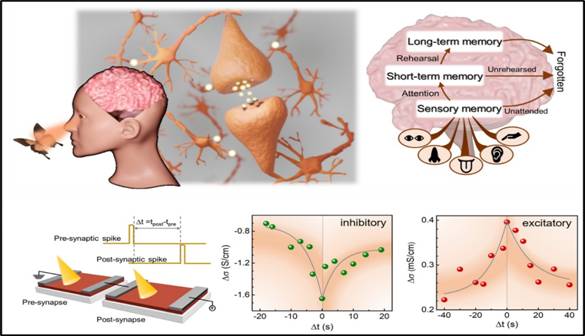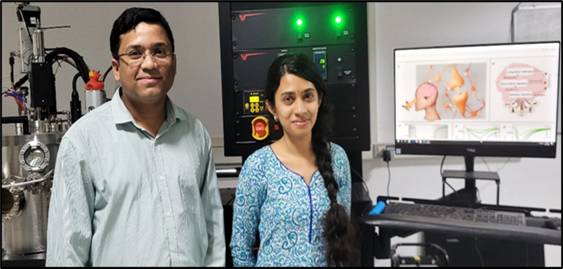Ministry of Science & Technology
Artificial synapse developed for brain-like computing with industry-compatible Nitride Semiconductors
प्रविष्टि तिथि:
25 JAN 2023 2:34PM by PIB Delhi
Scientists have used scandium nitride (ScN), a semiconducting material with supreme stability and Complementary Metal-Oxide-Semiconductor (CMOS) compatibility, to develop brain-like computing. This invention can provide a new material for stable, CMOS-compatible optoelectronic synaptic functionalities at a relatively lower energy cost and hence has the potential to be translated into an industrial product.
The traditional computers have physically separated memory storage and processing units. As a result, it takes enormous energy and time to transfer data between these units during an operation. On the contrary, the human brain is a supreme biological computer that is smaller and more efficient due to the presence of a synapse (the connection between two neurons) that plays the role of both processor and memory storage unit. In the current era of artificial intelligence, the brain-like computing approach can help meet the escalating computational demands. The development of neuromorphic hardware aims at mimicking a biological synapse that monitors and remembers the signal generated by the stimuli. Scientists have been trying to create an artificial synaptic device that does not suffer from RC delays, exhibits large bandwidth, consumes low energy, and is stable, scalable, and CMOS-compatible.

A team of scientists at Bengaluru’s Jawaharlal Nehru Centre for Advanced Scientific Research (JNCASR), an autonomous institute of the Department of Science and Technology, Government of India, who were working on nitride-based materials have used their background for developing hardware for neuromorphic computing. They used ScN to develop a device mimicking a synapse that controls the signal transmission as well as remembers the signal.
This work by Dheemahi Rao and team demonstrates an artificial optoelectronic synapse with ScN thin films that can mimic synaptic functionalities like short-term memory, long-term memory, the transition from short-term to long-term memory, learning–forgetting, frequency selective optical filtering, frequency-dependent potentiation and depression, Hebbian learning, and logic-gate operations.
Additionally, with varying magnesium (Mg) dopant concentrations, both excitatory (increase in current/synaptic strength) and inhibitory (decrease in current/synaptic strength) operations can be achieved in the same material that is not readily possible with other materials. The increase in resistivity (negative photoconductivity) in ScN and decrease in resistivity (positive photoconductivity) in Mg-doped ScN on shining light was used as the excitatory and inhibitory nature of the synapse, respectively. The persistence in the photoconductivity after turning off the light acts as a memory that lasts for several minutes to several days, depending on the nature of the stimuli. This work is the first demonstration of an optoelectronic synapse with a CMOS chip-compatible group-III nitride semiconductor.

Compared to the existing materials used to demonstrate optoelectronic synapse, ScN is more stable, CMOS compatible, and can be seamlessly integrated with existing Si technology. It can act as a platform for both excitatory and inhibitory functions. The industrial processing techniques of ScN are similar to the existing semiconductor fabrication infrastructure. Response to the optical stimuli also has the advantage of possible integration with photonic circuits known for higher speed and broader bandwidth than electronic circuits.
“Our work enables neuromorphic computing research with a stable, scalable, and CMOS-compatible III-nitride semiconductor that exhibits both excitatory and inhibitory synaptic functionalities. Unlike the previous works on all-electronic synapse, our work shows an optoelectronic synapse with a large bandwidth, reduced RC delays, and low power consumption.”- said Dr.BivasSaha, Assistant Professor at the Jawaharlal Nehru Centre for Advanced Scientific Research. Apart from JNCASR, researchers from the University of Sydney (Dr. Magnus Garbrecht and Dr. Asha I. K. Pillai) also participated in this study published recently in the scientific journal Advanced Electronic Materials.
Publication:
https://onlinelibrary.wiley.com/doi/full/10.1002/aelm.202200975
For more details, please contact Dr. BivasSaha, Email ID: bsaha@jncasr.ac.in, Mobile no.: +91-80-2208-2619
<><><><><>
SNC/RR
(रिलीज़ आईडी: 1893580)
आगंतुक पटल : 3282